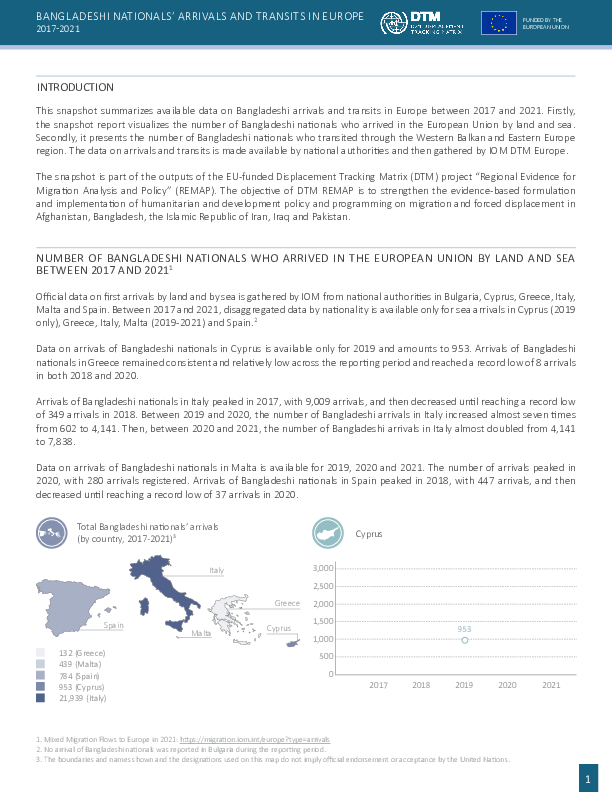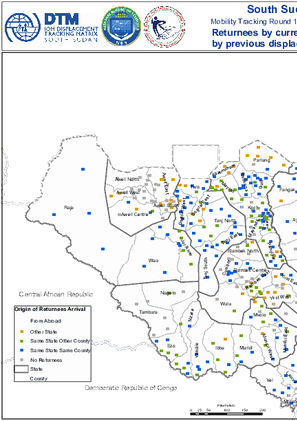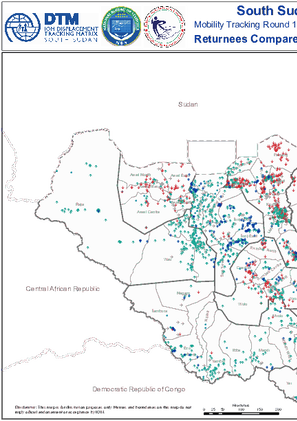-
Countries
-
Data and Analysis
-
Special Focus
-
Crisis Responses
IOM works with national and local authorities in order to gain a better understanding of population movements throughout Southern Africa. Through the setup of Flow Monitoring Points (FMPs), IOM seeks to quantify migration flows, trends and routes and to gain a better understanding of the profiles of observed individuals at entry, transit or exit points (such as border crossing posts, bus stations, rest areas, police checkpoints and reception centres). This report is an overview of the data collected in these FMPs from 1 to 30 April 2022.
Inter-regional migration from and within the Southern Africa is categorized along the following corridors. The Flow Monitoring Points (FMPs) were set-up in several key transit locations along the corridors to track the movements of passengers:
•Zimbabwe (Mutare) – Mozambique (Manica)
•Zimbabwe – Zambia (Chirundu)
•Zimbabwe – Botswana (Plumtree)
•Zimbabwe (Beitbridge) – South Africa
•Malawi (Mchinji) - Zambia (Mwami)
•Malawi (Karonga ) – United Republic of Tanzania
•Malawi (Mwanza) – Mozambique (Zobue)
•Malawi (Mulanje) – Mozambique
•Mozambique (Ressano Garcia) – South Africa
Over the reporting period a total of 68,733 movements were observed across 48 FMPs in the region. The Zimbabwe – South Africa corridor hosted the largest number of movements with 43,482 (63%) followed by the Malawi (Mwanza) – Mozambique (Zobue) corridor with 8,507 (12%) and the Zimbabwe – Zambia corridor with 3,858 movements reported (6%).

Contact
DTM Sudan; dtmsudan@iom.int
Language
English
Location
Sudan
Snapshot Date
May 12 2022
Activity
- Mobility Tracking
- Event Tracking
The DTM Emergency Event Tracking (EET) is deployed to track sudden displacement and population movements, provide more frequent updates on the scale of displacement, and quantify the affected population when needed. As a subcomponent of the new Mobility Tracking methodology in Sudan (Round Three), and activated on a need basis, EET utilises a broad network of key informants to capture best estimates of the affected population presence per location – a useful tool for humanitarian response planning and design.

Contact
IraqDTM@iom.int
Language
English
Location
Iraq
Period Covered
Oct 01 2019
Dec 31 2019
Activity
- Mobility Tracking
- Baseline Assessment
As the context in Iraq shifts from a humanitarian emergency to a protracted displacement crisis, more than 1.4 million people remain displaced throughout the country as of December 2019.
Further information is required to better understand the underlying causes of protracted displacement and the actions needed to enable durable solutions – whether to return to areas of origin (AoO), integrate into areas of displacement (AoD), or move to a third location. IOM Displacement Tracking Matrix (DTM), the Returns Working Group (RWG) and Social Inquiry (SI) have been working toward this objective, producing in November 2018 the first report “Reasons to Remain: Categorizing Protracted Displacement in Iraq,” which established a categorization framework for protracted displacement to enable future study. This report was followed by a number of publications on this topic, aiming among other things to identify the number of internally displaced persons (IDPs) that fall into each category, where they can be found, and most importantly, where they are from. Nonetheless, information gaps remain in terms of understanding displacement in urban contexts where a large proportion of IDP families are concentrated throughout the country.
To address this gap, DTM now aims to establish a breakdown of the remaining out-of-camp IDP caseload in the main urban centres of displacement to better understand the potential for durable solutions. Ten urban locations across eight of the main governorates of displacement have been selected for the assessment: Erbil city, Mosul city, Kirkuk city, Sulaymaniyah metropolitan, Baghdad city + Abu Graib, Zakho town, Dahuk city, Tooz Khormatu town, Tikrit city and Baquba city.

Contact
REMAPBD@iom.int
Language
English
Location
Bangladesh
Period Covered
Jan 01 2017
Dec 31 2021
Activity
- Flow Monitoring
This snapshot summarizes available data on Bangladeshi arrivals and transits in Europe between 2017 and 2021. Firstly, the snapshot report visualizes the number of Bangladeshi nationals who arrived in the European Union by land and sea. Secondly, it presents the number of Bangladeshi nationals who transited through the Western Balkan and Eastern Europe region. The data on arrivals and transits is made available by national authorities and then gathered by IOM DTM Europe.
The snapshot is part of the outputs of the EU-funded Displacement Tracking Matrix (DTM) project “Regional Evidence for Migration Analysis and Policy” (REMAP). The objective of DTM REMAP is to strengthen the evidence-based formulation and implementation of humanitarian and development policy and programming on migration and forced displacement in Afghanistan, Bangladesh, the Islamic Republic of Iran, Iraq and Pakistan.

Contact
dtmremapsupport@iom.int, isbdtmremapteam@iom.int
Language
English
Location
Pakistan
Period Covered
Jan 01 2019
Dec 31 2021
Activity
- Other
Remittances sent by millions of Pakistani migrants worldwide have supported the country’s economy by improving livelihoods and easing the pressure at times of economic crisis, such as energy crises, food insecurity and higher foreign debt repayments (Ahmed, 2021). Remittances are the second largest source of foreign exchange in the country, making Pakistani emigrants crucial actors in the balance of the payment deficit (Khan et al., 2021). The country is among the top recipients of remittances globally (World Bank, 2021). Recent studies showed that remittance inflows to Pakistan proved resilient during the COVID-19 pandemic, defying all predictions (IOM, 2021).

Contact
iomisbdtmremapteam@iom.int
Language
English
Location
Pakistan
Period Covered
Apr 23 2022
May 06 2022
Activity
- Flow Monitoring
IOM Pakistan collects data on the outflows of undocumented Afghan migrants at the Torkham and Chaman border crossing points in an effort to better understand the migration movements of undocumented Afghan migrants returning to Afghanistan from Pakistan. This exercise is part of the European Union funded project “Displacement Tracking Matrix Regional Evidence for Migration Analysis and Policy (DTM REMAP)”.
From 23 April to 06 May 2022, 805 undocumented Afghan migrants returned to Afghanistan, including 265 through the Torkham border point and 540 through the Chaman border point. During the reporting period, border authorities facilitated the return of 59 individuals due to the lack of legal documentation to remain in Pakistan. Therefore, information concerning these 59 individuals is not included in the report analysis.

Contact
vlutenco@iom.int
Language
Mongolian
Location
Mongolia
Period Covered
Feb 01 2022
Feb 28 2022
Activity
- Mobility Tracking
- Baseline Assessment
ОУШХБ-ын өмнөх судалгаануудаар газрын доройтол, уур амьсгалын өөрчлөлт зэрэг асуудлууд нь Монголын уламжлалт амьдралын хэв маягийг өөрчилж байгааг тогтоожээ. Ган зудын давтамж нэмэгдэж, ажлын байр хомс, амьдрах орчин нөхцөл шаардлага хангахгүй, хөдөөгийн хүн ам малаас хэт хараат болсон зэрэг нь хөдөөгийн хүн амын амьжиргааг залгуулах боломжийг өдрөөс өдөрт бууруулсаар байна. Үүний зэрэгцээ энэ байдал нь хот суурин газар болон бусад аймгийн төв рүү чиглэсэн шилжилт хөдөлгөөнийг нэмэгдүүлэх хүчин зүйл болсоор байна. Эдгээр шинээр гарч ирж буй шилжилт хөдөлгөөний (хүн амын хөдөлгөөн) хэв маяг нь тооллогын, бүртгэлийн мэдээлэл болон Монгол Улсын хэмжээнд амьдарч буй хүмүүсийн бодит тоон мэдээлэл хооронд ихээхэн зөрүү үүсгэсээр байна. Энэхүү туршилтын судалгаагаар ҮСХ болон ОУШХБ нь хамтран Өмнөговь, болон Дундговь аймгуудад багийн байршил дээрх хүн амын бодит тоог тандах зорилгоор Хүн амын хөдөлгөөнийг тандах матрицын “Хөдөлгөөний тандалт” – MT (Mobility Tracking) аргачлалыг ашиглахыг зорьсон юм.

Contact
vlutenco@iom.int
Language
English
Location
Mongolia
Period Covered
Feb 01 2022
Feb 28 2022
Activity
- Mobility Tracking
- Baseline Assessment
Previous IOM studies have found that a combination of complex effects including land degradation and climate change are altering traditional livelihood patterns in Mongolia. In a context of increased frequency of droughts and dzuds, the lack of job opportunities, inadequate living conditions, and the dependency of the rural population on livestock reduced the rural population's ability to earn a living. At the same time, this situation increased migration to urban areas and other aimags in unprecedented and unexplored ways. These emerging migration patterns created a large discrepancy between census data, registration data, and actual number of people living in the various baghs in Mongolia. With this study, IOM and NSO intend to use the Mobility Tracking (MT) methodology of the Displacement Tracking Matrix (DTM) toolbox to track the real number of people living in the various baghs in Dundgovi aimags.
This map shows the payams returnees are currently in. Where returnees' origin states and counties are different to those of their currently mapped location, this is indicated (Mobility Tracking Round 11, September 2021).
This map shows the direction of change in the number of returnees as mapped by round eleven of Mobility Tracking, at the location level (Mobility Tracking Round 11, September 2021).


